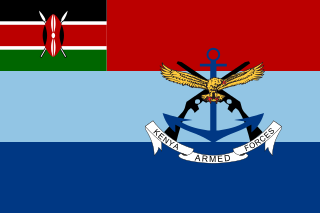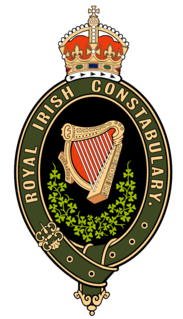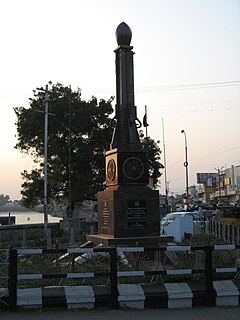Related Research Articles

The Kenya Defence Forces (KDF) are the armed forces of the Republic of Kenya. They are made up of the Kenya Army, Kenya Navy, and Kenya Air Force. The current KDF was established, and its composition stipulated, in Article 241 of the 2010 Constitution of Kenya; it is governed by the KDF Act of 2012. Its main mission is the defence and protection of the sovereignty and territorial integrity of Kenya, recruitment to the KDF is done on yearly basis. The President of Kenya is the commander-in-chief of the KDF, and the Chief of Defence Forces is the highest-ranking military officer, and the principal military adviser to the President of Kenya.

Mutiny is a revolt among a group of people to oppose, change, or overthrow an organization to which they were previously loyal. The term is commonly used for a rebellion among members of the military against an internal force, but it can also sometimes mean any type of rebellion against any force. Mutiny does not necessarily need to refer to a military force and can describe a political, economic, or power structure in which there is a change of power.
A constable is a person holding a particular office, most commonly in criminal law enforcement. The office of constable can vary significantly in different jurisdictions. A constable is commonly the rank of an officer within the police. Other people may be granted powers of a constable without holding this title.

The Philippine Constabulary was a gendarmerie-type police force of the Philippines from 1901 to 1991, and the predecessor to the Philippine National Police. It was created by the American colonial government to replace the Spanish colonial Guardia Civil, happened on the 19th century history of the Philippines. It was the first of the four branches of the Armed Forces of the Philippines. On January 29, 1991, it was merged with the Integrated National Police to form the Philippine National Police.

The Royal Irish Constabulary was the police force in Ireland from 1822 until 1922, when all of the country was part of the United Kingdom. A separate civic police force, the unarmed Dublin Metropolitan Police (DMP), patrolled the capital and parts of County Wicklow, while the cities of Derry and Belfast, originally with their own police forces, later had special divisions within the RIC. For most of its history, the ethnic and religious makeup of the RIC broadly matched that of the Irish population, although Anglo-Irish Protestants were over-represented among its senior officers.

The Ulster Special Constabulary was a quasi-military reserve special constable police force in what would later become Northern Ireland. It was set up in October 1920, shortly before the partition of Ireland. It was an armed corps, organised partially on military lines and called out in times of emergency, such as war or insurgency. It performed this role most notably in the early 1920s during the Irish War of Independence and the 1956-1962 IRA Border Campaign.

The Indian Rebellion of 1857 was a major uprising in India in 1857–58 against the rule of the British East India Company, which functioned as a sovereign power on behalf of the British Crown. The rebellion began on 10 May 1857 in the form of a mutiny of sepoys of the Company's army in the garrison town of Meerut, 40 mi (64 km) northeast of Delhi. It then erupted into other mutinies and civilian rebellions chiefly in the upper Gangetic plain and central India, though incidents of revolt also occurred farther north and east. The rebellion posed a considerable threat to British power in that region, and was contained only with the rebels' defeat in Gwalior on 20 June 1858. On 1 November 1858, the British granted amnesty to all rebels not involved in murder, though they did not declare the hostilities to have formally ended until 8 July 1859. Its name is contested, and it is variously described as the Sepoy Mutiny, the Indian Mutiny, the Great Rebellion, the Revolt of 1857, the Indian Insurrection, and the First War of Independence.
An inspector general is an investigative official in a civil or military organization. The plural of the term is "inspectors general".
Abu Taher was a Bengali military serviceman, who served in the Pakistan Army, and later in BDF. He crossed into India around early August and reported to the Indian authorities. After a week screening at Dehradun, India, Taher reported to Kolkata, Bangladesh Provincial government at 8 Theatre Rd. He was ordered to report to Sector 11 of Mukti Bahini under command of Major Ziaur Rahman, he became the sector commander after him. He served in BDF from end of August to 2 November 1971. He was awarded the medal Bir Uttom for his gallantry in the liberation war. He was released from military service by Indian military medical board in Pune, India after his leg was amputated. After independence, he was inducted into the Bangladesh Army for administrative retirement with legacy rank of Lieutenant Colonel. After settling in with family, the government of Bangladesh appointed him with employment at Kumilla. Later Taher turned into a political activist and leader of the left-wing Jatiyo Samajtantrik Dal.

Camp General Emilio Aguinaldo (CGEA), also known as Camp Aguinaldo, is the site of the general headquarters (GHQ) of the Armed Forces of the Philippines (AFP) located in eastern Metro Manila, the Philippines.

The Royal Indian Navy mutiny or revolt, also called the 1946 Naval Uprising, was an insurrection of Indian naval ratings, soldiers, police personnel and civilians against the British government in India. From the initial flashpoint in Bombay, the revolt spread and found support throughout British India, from Karachi to Calcutta, and ultimately came to involve over 20,000 sailors in 78 ships and shore establishments.
The Bidadari Resolutions were set of resolutions adopted by the nascent Indian National Army in April 1942 that declared the formation of the INA and its aim to launch an armed struggle for Indian independence. The resolution was declared at a prisoner-of-war camp at the Bidadari in Singapore during Japanese occupation of the island.

The regiments of Bengal Native Infantry, alongside the regiments of Bengal European Infantry, were the regular infantry components of the East India Company's Bengal Army from the raising of the first Native battalion in 1757 to the passing into law of the Government of India Act 1858. At this latter point control of the East India Company's Bengal Presidency passed to the British Government. The first locally recruited battalion was raised by the East India Company in 1757 and by the start of 1857 there were 74 regiments of Bengal Native Infantry in the Bengal Army. Following the Mutiny the Presidency armies came under the direct control of the United Kingdom Government and there was a widespread reorganisation of the Bengal Army that saw the Bengal Native Infantry regiments reduced to 45.

Private James Joseph Daly was a member of a mutiny of the Connaught Rangers in India in 1920 in protest of the activities of the Royal Irish Constabulary and the Black and Tans in Ireland. He was executed in the aftermath of the mutiny by Crown forces.

The Vellore mutiny, or Vellore Revolution, occurred on 10 July 1806 and was the first instance of a large-scale and violent mutiny by Indian sepoys against the East India Company, predating the Indian Rebellion of 1857 by half a century. The revolt, which took place in the South Indian city of Vellore, lasted one full day, during which mutineers seized the Vellore Fort and killed or wounded 200 British troops. The mutiny was subdued by cavalry and artillery from Arcot. Total deaths amongst the mutineers were approximately 350; with summary executions of about 100 during the suppression of the outbreak, followed by the formal court-martial of smaller numbers.
The State Armed Police Forces of India are the police units established for dealing with serious law and order situations requiring a higher level of armed expertise than normal. The State Armed Police Forces exist in addition to the ordinary police services of the various states.
Uttar Pradesh Provincial Armed Constabulary (UP-PAC) or Pradeshik Armed Constabulary (PAC) is an armed police of the Indian state of Uttar Pradesh. It is maintained at key locations across the state and active only on orders from the deputy inspector general and higher-level authorities. It is usually assigned to VIP duty or to maintain law and order during fairs, festivals, athletic events, elections, and natural disasters. They are also deployed to quell outbreaks of student or labor unrest, organized crime, and communal riots; to maintain key guard posts; and to participate in antiterrorist operations. The Provincial Armed Constabulary is equipped with INSAS semi automatic guns and usually carries only lathis while controlling the mob during unrests. UP-PAC consists of a total of 20,000 personnel as of 2005, composed of 36 battalions located in different cities across the state as a wing of Uttar Pradesh Police. Each battalion is commanded by a Commanding Officer(CO) who is usually an IPS officer of Senior Superintendent rank, and has seven to eight companies consisting of 120 to 150 Jawans, each company headed by a State Police officer of Inspector rank, who is usually referred to as company commander in the PAC and below company there are several platoon consisting of 20-25 Jawans, each platoon is usually headed by a Sub-Inspector rank state police officer. The PAC is headed by the Director General Provincial Armed Constabulary.
40 Field Regiment , nicknamed the Roaring Forty is part of the Regiment of Artillery of the Indian Army.
References
- ↑ M. B. Chande (1997). The police in India. Atlantic Publishers & Dist. p. 473. ISBN 9788171566280 . Retrieved 25 June 2013.
- ↑ Robert L. Hardgrave, Jr.; Stanley A. Kochanek (2008). India: Government and Politics in a Developing Nation. Cengage Learning. ISBN 978-0495007494 . Retrieved 25 June 2013.
- ↑ N.S. Saksena (1985). Terrorism History and Facets: In the World and in India. Abhinav Publications. p. 193. ISBN 9788170172017 . Retrieved 25 June 2013.